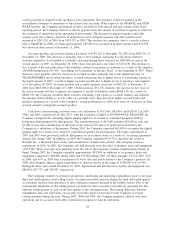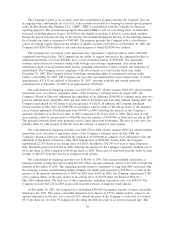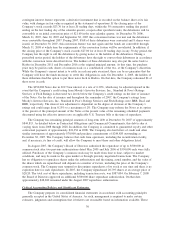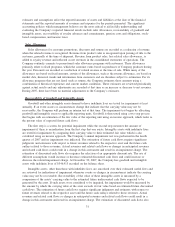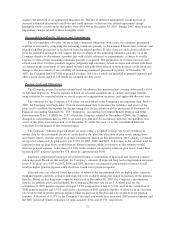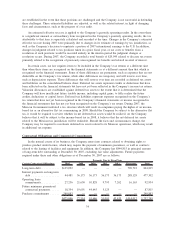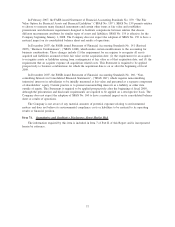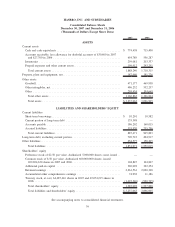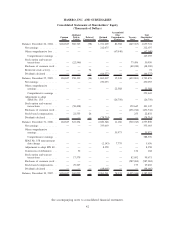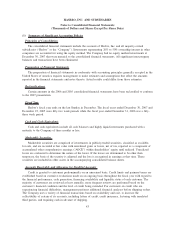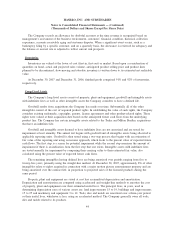Hasbro 2007 Annual Report Download - page 42
Download and view the complete annual report
Please find page 42 of the 2007 Hasbro annual report below. You can navigate through the pages in the report by either clicking on the pages listed below, or by using the keyword search tool below to find specific information within the annual report.
are established in the event that these positions are challenged and the Company is not successful in defending
these challenges. These estimated liabilities are adjusted, as well as the related interest, in light of changing
facts and circumstances, such as the progress of a tax audit.
An estimated effective tax rate is applied to the Company’s quarterly operating results. In the event there
is a significant unusual or extraordinary item recognized in the Company’s quarterly operating results, the tax
attributable to that item is separately calculated and recorded at the time. Changes in the Company’s estimated
effective tax rate during 2007 were primarily due to changes in its estimate of earnings by tax jurisdiction, as
well as the Company’s decision to repatriate a portion of 2007 international earnings to the U.S. In addition,
changes in judgment related to tax positions taken in a prior fiscal year, or tax costs or benefits from a
resolution of such positions would be recorded entirely in the interim period the judgment changes or
resolution occurs. During 2007, the Company recorded a total benefit of $29,999 related to discrete tax events
primarily related to the recognition of previously unrecognized tax benefits and related reversal of interest.
In certain cases, tax law requires items to be included in the Company’s tax returns at a different time
than when these items are recognized on the financial statements or at a different amount than that which is
recognized on the financial statements. Some of these differences are permanent, such as expenses that are not
deductible on the Company’s tax returns, while other differences are temporary and will reverse over time,
such as depreciation expense. These differences that will reverse over time are recorded as deferred tax assets
and liabilities on the consolidated balance sheet. Deferred tax assets represent credits or deductions that have
been reflected on the financial statements but have not yet been reflected in the Company’s income tax returns.
Valuation allowances are established against deferred tax assets to the extent that it is determined that the
Company will have insufficient future taxable income, including capital gains, to fully realize the future
credits, deductions or capital losses. Deferred tax liabilities represent expenses recognized on the Company’s
tax return that have not yet been recognized in the Company’s financial statements or income recognized in
the financial statements that has not yet been recognized on the Company’s tax return. During 2007, the
Mexican Government instituted a tax structure which will result in companies paying the higher of an income-
based tax or an alternative flat tax commencing in 2008. Should the Company be subject to the alternative flat
tax, it would be required to review whether its net deferred tax assets would be realized. As the Company
believes that it will be subject to the income-based tax in 2008, it believes that the net deferred tax assets
related to the Mexican tax jurisdiction will be realizable. Should the facts and circumstances change, the
Company may be required to reevaluate deferred tax assets related to its Mexican operations, which may result
in additional tax expense.
Contractual Obligations and Commercial Commitments
In the normal course of its business, the Company enters into contracts related to obtaining rights to
produce product under license, which may require the payment of minimum guarantees, as well as contracts
related to the leasing of facilities and equipment. In addition, the Company has $844,815 in principal amount
of long-term debt outstanding at December 30, 2007, excluding fair value adjustments. Future payments
required under these and other obligations as of December 30, 2007 are as follows:
Certain Contractual Obligations 2008 2009 2010 2011 2012 Thereafter Total
Payments Due by Fiscal Year
Long-term debt ............ $135,092 — — — — 709,723 844,815
Interest payments on long-term
debt .................. 44,481 36,173 36,173 36,173 36,173 288,129 477,302
Operating lease
commitments............ 27,236 21,650 10,828 9,793 7,262 16,165 92,934
Future minimum guaranteed
contractual payments ...... 18,354 19,691 44,645 5,125 — — 87,815
Purchase commitments ...... 249,883 — — — — — 249,883
$475,046 77,514 91,646 51,091 43,435 1,014,017 1,752,749
34






